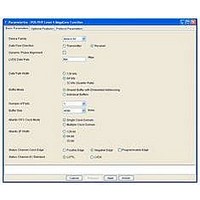IPR-POSPHY4 Altera, IPR-POSPHY4 Datasheet - Page 38

IPR-POSPHY4
Manufacturer Part Number
IPR-POSPHY4
Description
IP CORE Renewal Of IP-POSPHY4
Manufacturer
Altera
Type
MegaCorer
Specifications of IPR-POSPHY4
Software Application
IP CORE, Interface And Protocols, COMMUNICATION
Supported Families
Arria GX, Cyclone, HardCopy, Stratix
Core Architecture
FPGA
Core Sub-architecture
Arria, Cyclone, Stratix
Rohs Compliant
NA
Function
POS-PHY Level 4 Interface, Link-Layer/PHY Layer
License
Renewal License
Lead Free Status / RoHS Status
na
Lead Free Status / RoHS Status
na
- Current page: 38 of 144
- Download datasheet (3Mb)
3–16
POS-PHY Level 4 MegaCore Function User Guide
Receiver Options
1
1
Although the MegaWizard interface allows you to set FTH values as low as one FIFO
buffer element (translated to bytes), a minimum FTH value is used internally. And,
depending on the core's configuration, up to four FIFO buffer locations are unusable.
For the exact minimum FTH value and number of unusable locations, refer to the
MegaWizard interface message that appears while configuring the core.
The Almost empty (AE) and Almost full (AF) thresholds segregate the receiver FIFO
buffer into three states, depending on the fill levels: starving, hungry, and satisfied.
The SPI-4 Phase 2 specification defines two-bit status values for starving, hungry, and
satisfied. These two-bit values are based on the available space in the FIFO buffer and
on the AE and AF parameter settings:
■
■
■
The starving, hungry, and satisfied conditions are reported to the adjacent transmitter
on the rstat bus, which operates at up to ¼ of the rdclk frequency.
These thresholds are defined in terms of bytes, with a valid range from zero to buffer
size.
AE must be lower than or equal to AF.
Figure 3–5
MaxBurst1 and MaxBurst2 values.
Figure 3–5. FIFO Buffer Thresholds
Notes to
(1) L
(2)
(3) The MaxBurst1 and MaxBurst2 values are defined by the adjacent device’s transmitter. Determining the optimal
Starving—when the number of elements in the FIFO buffer is less than, or equal to,
the AE threshold
Hungry—when the number of elements in the FIFO buffer is between the AE
threshold and the AF threshold
Satisfied—when the number of elements in the FIFO buffer is greater than the AF
threshold
observing the reaction to that update on the corresponding data path.
ε
from various protocol overheads.
MaxBurst1 and MaxBurst2 values is application-specific, and requires an analysis of the data flows, beyond the
scope of this user guide.
MAX
corresponds to the difference between the granted credit and the actual data transfer length. This difference arises
Figure
corresponds to the worst-case response time from sending a status update over the FIFO status channel until
illustrates the relationship between the AE and AF thresholds and the
(Empty)
3–5:
Lmax + ε
Starving
AE
Hungry
Lmax + MaxBurst1+ ε
AF
Lmax + MaxBurst2+ ε
Satisfied
December 2010 Altera Corporation
Chapter 3: Parameter Settings
(Full)
Protocol Parameters
Related parts for IPR-POSPHY4
Image
Part Number
Description
Manufacturer
Datasheet
Request
R

Part Number:
Description:
IP NIOS II MEGACORE RENEW
Manufacturer:
Altera
Datasheet:

Part Number:
Description:
IP CORE Renewal Of IP-XAUIPCS
Manufacturer:
Altera
Datasheet:

Part Number:
Description:
IP CORE Renewal Of IP-10GETHERNET
Manufacturer:
Altera
Datasheet:

Part Number:
Description:
IP CORE Renewal Of IP-ASI
Manufacturer:
Altera
Datasheet:

Part Number:
Description:
IP CORE Renewal Of IP-CIC
Manufacturer:
Altera
Datasheet:

Part Number:
Description:
IP CORE Renewal Of IP-CRC
Manufacturer:
Altera
Datasheet:

Part Number:
Description:
IP CORE Renewal Of IP-ED8B10B
Manufacturer:
Altera
Datasheet:

Part Number:
Description:
CPLD, EP610 Family, ECMOS Process, 300 Gates, 16 Macro Cells, 16 Reg., 16 User I/Os, 5V Supply, 35 Speed Grade, 24DIP
Manufacturer:
Altera Corporation
Datasheet:

Part Number:
Description:
CPLD, EP610 Family, ECMOS Process, 300 Gates, 16 Macro Cells, 16 Reg., 16 User I/Os, 5V Supply, 15 Speed Grade, 24DIP
Manufacturer:
Altera Corporation
Datasheet:

Part Number:
Description:
Manufacturer:
Altera Corporation
Datasheet:










